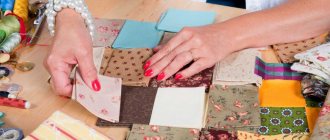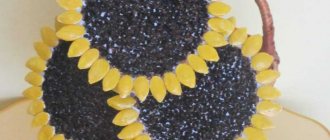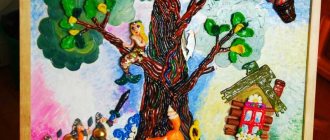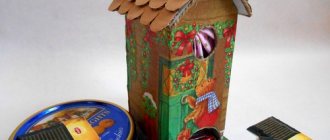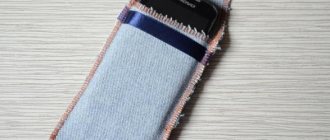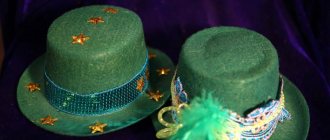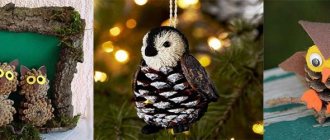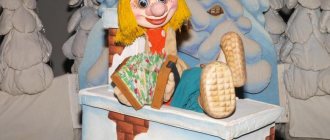Textile decor is not only stylish and original, but also very simple, even for inexperienced needlewomen. You can make voluminous, flat flowers from any fabric. They are fully capable of replacing living plants, which cannot always withstand temperature changes and the transience of time. Artificial roses, tulips, and chrysanthemums have been held in high esteem in any period of history. They were performed using a variety of techniques. To achieve maximum resemblance to the buds, many methods were tried.
Fine Jewelry
Using miniature fabric flowers, craftswomen create hairpins and headbands, bracelets and brooches, necklaces and other jewelry that elegantly complement an outfit or serve as a worthy gift for a beloved friend.
Using thin fabric, you can repeat the ideal shape of a flower and make stylish and luxurious jewelry or accessories.
Making fabric flowers with your own hands brings a lot of pleasure and emphasizes the individuality of the craftswoman. To make original gizmos you will need a little fabric, but the result will exceed all expectations.
Artificial floristry
Creating artificial flowers is a whole science. Simple flowers that can be used to decorate a girl’s dress do not require much time or materials. Even novice masters can handle them. But flowers that look as much like real ones as possible require painstaking work. They can be a great addition to a wedding dress or part of a bride's bouquet.
A duplicate bouquet created from fabric flowers will not wither or lose its appearance and will help preserve the memories of your happiest day.
To make these flowers you will need:
- Pattern. It is most often removed by disassembling the real flower into individual petals;
- Textile. For work, it is better to choose thin fabrics - satin, crepe de Chine, chiffon, silk, satin, organza;
- Bulki. This tool can be purchased at an arts and crafts store. Bulks are balls of different diameters attached to a handle. The spherical shape will help imitate the natural curves of a flower petal;
- Aniline dyes for fabric are needed to tint the petals, thereby giving them a natural look;
- Scissors, a spatula for curling the edge of the petal, an awl, glue, tweezers;
- Burner. Fabric subjected to heat treatment easily takes and retains its desired shape;
- Decorative elements – pistils, stamens;
- Rubber pad. The petal is pressed into it with a bubble and given its shape.
Related article: Types of patchwork for beginners in pictures with videos
Now let's see how to make a flower. You may not need more of the tools listed above. The simplest flowers can be made from small circles of different diameters.
Note! The more layers of fabric you take while working, the more magnificent the finished product will be.
Prepare several circles from the fabric of your choice. The fabric needs to be cut correctly, this is done “on the bias”. To transfer patterns, do not use simple pencils, because... graphite smears and stains the material. Use a colored ballpoint pen. Carry out the cutting just below the outlined outline.
Using a torch or candle, slightly melt the edges of the workpieces. The process is shown in the photo.
Connect the resulting parts with thread.
You need to make stamens in the center of the flower. To do this, use purchased decorative elements or make them yourself.
A lush rose is made in the same way. It is based on circular petals of different diameters.
The petals are processed with bulk.
If you want to decorate the dress with a brooch, make a felt backing and attach the necessary accessories to it.
These simple flowers will be an excellent decoration for both wedding and everyday dresses.
An exciting activity or a magical hobby
People began to create things similar to the creations of nature a long time ago. The hands of the craftswomen tried many methods and manufacturing techniques to achieve similarity with natural flowers.
To make the petals convex, they used starch, gelatin, and squeezed them out with special tools, giving them the desired shape.
The easiest and fastest way to make fabric flowers with your own hands for beginners is to create buds by sewing strips of fabric or ribbons together.
Made from linen
Flax flowers are made from beaded flax. Cut a strip 19 cm long. We retreat 2 cm on both sides and pull the thread 2 cm, that is, remove it completely from the strip. Then we pull the middle through one thread. Coat and glue. Insert a toothpick and twist a strip onto it. Carefully remove the toothpick and coat the bottom of the flower with glue. When it dries, open it. A good set for denim trousers, skirts, jackets, various bags, belts and so on.
Fabric strip rose
A long strip of any material folded in half is rolled into a tight roll. The petals are formed by turning the tape along the bias guide of the fabric. For 1 row you need to fold the tape 3-5 times. To get a lush bud you need to increase the rows.
With each subsequent row of revolutions you will need more. Carefully straighten the resulting petals and fix them with a needle and thread or a glue gun. When you receive a flower of the desired size, grease the end of the tape with glue and glue it to the underside of the rose.
Spring inspiration to help craftswomen
Modern girls are increasingly bolder in decorating their knitted hats with all available materials. It turns out fresh, original, not boring! Every young lady can create her own highlight. Decorating with large rhinestones can be a great idea. It takes little time, but it turns out very beautiful. Any monochromatic item turns into an original accessory.
It is best to attach rhinestones to the lapel of a cap. Before starting work, select rhinestones of different shapes, arrange them as your imagination dictates, and start attaching them. You can glue any repeating motif and even the first letter of your name.
To secure the elements, use a glue gun:
- First, draw a picture on paper of how the rhinestones will be positioned. For example, from large crystals, make flowers that will appear as if in a haze created by an environment of small crystals.
- Lay out the details on it.
- First glue the large pieces to the hat.
- Start gluing small ones behind them, just don’t overdo it. The headdress looks beautiful when only its front part is decorated.
Modern manufacturing techniques
Over time, new directions for creating fabric flowers have appeared, one of which is the Japanese Kanzashi technique - folding petals from squares of fabric or satin ribbons.
Flowers made of synthetic textiles, made by the “hot method” - by treating the edges of the petals with a burning candle - look as if they were alive. The petals, melted at the edges, curl up and take on a curved shape.
You can create your own flowers from fabric using the method of crimping, stitching and gluing petals. Needlewomen learn the art of creating flowers using instructions, recommendations, and videos that help them learn the intricacies of this type of creativity.
Varieties of decor
Needlewomen have come up with so many options for decorating hats that you can easily choose the most original one.
Flowers made of thick drape or felt will decorate any headdress
- Cut a piece of felt and cut it into strips of the width you need.
- Sew the ends of the strips together, assemble them into a flower, and make petals.
- Decorate each felt strip with tiny rhinestones to make them sparkle in the sun.
Such an unusual wardrobe item will attract all the looks of others.
Pattern knitting
A headdress knitted with knitting needles does not need to be decorated. The knitting itself is a decoration.
The fantastic pattern created by entwined loops amazes the imagination.
Flowers of different types
Textile decor is becoming one of the original and stylish ways of decoration. Flowers can be flat, voluminous, collected in a bouquet, wreath, composition or panel.
Products can be created from felt, burlap, denim. They are suitable for decorating large objects. And cute creations made from nylon, organza, fine knitwear, chiffon look elegant, delicate and close in appearance to the original.
The choice of fabric for the product depends on the purpose of the decorative element - a flower on a stem, an element of wall decoration, clothing or a wedding wreath.
Note!
- DIY satin ribbon bows: photos of original design ideas, step-by-step DIY master class
- DIY hair bands - ideas for decorating homemade rubber bands + step-by-step instructions for making them yourself
- DIY shadow theater: step by step how to do it at home! 175 real photos
Having mastered the technique of work, you can reproduce flowers from the fabric of leading masters, guided by master classes, or create an original product, emphasizing your individual style.
Materials used to make flowers
Before you start making flowers, a question arises. What fabric can flowers be made from? Below are materials that are great for making flowers.
Chiffon
This material has the finest structure, which makes it incredibly soft and light. Chiffon is most often used when sewing wedding or evening dresses. From this material you can make flowers that will decorate both everyday and formal outfits.
The color palette of chiffon is limitless. The material can be plain, colored, or sprayed. Chiffon is easy to work with due to the absence of a reverse side.
Silk
Silk flowers are as natural as possible. If you look at them from a long distance, they cannot be distinguished from real flowers. The material is easy to cut and form volume. Its advantage is that it does not wrinkle. Silk jewelry always looks stylish and elegant.
Organza
Organza flowers look very stylish and unique. The material takes the shape created by the manufacturer, which will allow you to create a unique flower. Roses and orchids are most often made from organza, as this material can emphasize the fragility and tenderness of these flowers.
Atlas
A satin flower is made multi-layered. A cardboard blank is used for this. Each petal is laid in several layers, and the tip is necessarily singed. In order for such a flower to keep its shape, it should be starched. Ribbons can also be used together with satin: lace, grosgrain, nylon.
Chintz
Calico flowers are pleasant to the touch and very soft. Products made from chintz most often decorate children's clothes, towels, bed linen, and pillows. Calico flower petals are made from special patterns, and in order for the flower to keep its shape, it is made on a round cardboard blank.
Felt
It is recommended that beginners begin their creative work with this material. Due to the peculiarities of the structure, flowers made of this material hold their original shape well. Felt flowers can be made both simple and complex, with various additional elements. Felt makes excellent chrysanthemums, poppies and roses.
Note!
- Ideas for LD (a girl’s personal diary): step-by-step instructions for making it yourself, photo reviews of the best options
- Educational soft books made of felt: materials for making, detailed instructions + reviews of plots for books (100 photos)
- Original do-it-yourself valentines - design options, necessary materials, master class for DIY work
Good mood for creativity
Good taste, imagination and imagination simply encourage you to engage in this type of creativity. This exciting activity will require accuracy, patience and perseverance.
To work you will need fabric, scissors, a needle and thread, a glue gun, brushes and paints, and most importantly, a good mood! This exciting type of needlework will seem not like work, but like relaxation, which will relieve stress and help you forget about your current problems at least for a while.
To make flowers from fabric, you will need copper, steel or aluminum wire for the stems, fishing line or nylon thread to create decorated fragments from beads and beads, cotton wool to create unopened buds, as well as semolina or crushed coal to imitate stamens and pollen.
What you need for needlework
To create decorative flowers you will need additional accessories and tools.
- Elements are painted with gouache, ink, photo paint, printer ink, and food coloring. Acrylic-based paint is not suitable for finishing work.
- Brushes with soft and hard bristles.
- Adhesive compositions - stationery and for textiles.
- Wire for forming leaves and stems in bouquet arrangements.
- Transparent fishing line for attaching small elements - beads, beads.
- Felt or crepe paper, cotton wool to create a base and support the shape of the product.
- Needles and thick threads for stitching elements.
- Rubber pad to create a corrugated pattern.
- A set of tools for handicrafts made of brass: scissors, hooks, tweezers, hooks and so on.
Templates for creating buds
The templates are circles of different diameters. The bottom circle will be the largest. It will be 1 cm larger than the future flower. Cut subsequent circles 0.5 cm smaller than the previous (bottom) one.
The more magnificent the bud, the more circles will be needed. To create a very lush bud you need 3-4 circles of each diameter. Then transfer these template circles onto the fabric and make cuts according to the number of petals.
Usually 4 petals are made. They need to be rounded off with nail scissors and the edges burned over a candle flame. The blanks are fastened together in decreasing order - a blank with larger petals is placed on a blank with a smaller diameter, stitched or glued together.
Leave the middle free for the core or stamens. As a result, the whole process of work consists of cutting out the petals, processing them with a candle, collecting and securing the petals. An affordable and fairly simple option, and the result will surprise you.
Note!
- DIY bracelets | Selection of the best models and master class on making beautiful bracelets
- DIY bird feeder - interesting ideas on how to make it quickly and easily from scrap materials
- Do-it-yourself cold porcelain: the best options for porcelain products, step-by-step instructions and recipes for making it yourself (photo + video)
Felt dahlias
Fabric flowers can be made not only from thin and translucent material. To decorate outerwear, you can use felt or other rough fabric that does not need to be burned.
Cut a circle with a diameter of 5 mm from the fabric. This circle will serve as the basis on which all the petals will be glued.
The details of the petals are isosceles pentagons. They can be cut from circles of fabric with a diameter of 3, 2.5 and 2 mm. To work, you will need 16 petals of each size.
For the center, make three squares with sides of 3, 2.5 and 2 mm. Trim the corners and you will have three round flower pieces. Cut them in a circle at a distance of approximately 0.5 mm between cuts and in depth.
Fold one of the edges of the pentagon together, coat it with glue and form a petal. Prepare all the pentagons in the same way. Start gluing them to the outer edge of the base in a circle. Glue the largest petals first, then the medium ones, and lastly the small ones. You will get three rows, and the center of the base will remain empty.
Take the largest circle with cut edges in your hands. Glue a smaller circle in its center. Then glue the smallest circle there. Place this part and glue it into the center of the flower base.
Product painting
To make it more like a natural flower, its petals are painted. On dark fabric, the folds are painted with lighter colors. And fabrics of white, pale pink or cream shades of brightness will add color to a tone darker.
To obtain a smooth transition, the fabric must be moistened before painting. Flower painting is an incredible art, once you get acquainted with it, it is impossible to stop the flow of creative inspiration.
Within one petal, you can use several shades of a suitable color, and then the effect will be simply stunning. Such painting will add three-dimensionality and a resemblance to naturalness to the products.
After drying, bend each petal in the desired direction. They can be bent inward and twisted outward - the buds will look like a blossoming or blooming flower. The beautiful curves of the petals are given by fabric that stretches in all directions.
Camellia from foamiran
Make light pink or white petals. We will need a five-petal base, 2 bases with four petals, three bases with three petals. They can be cut from circles with a diameter of 4.5, 3 and 2.5 mm. In addition, another 7-8 petals should be made separately. The petals need to be slightly shaded with pastels, giving them a pink tint around the edges. It is better to apply pastel with your fingers in small quantities.
To shape the petals, you need to heat them for a few seconds on an iron, and then pull them onto a metal round shape.
To form the center, you need to tightly screw a cone of cotton wool onto the stem, which will serve as the basis for gluing the petals.
The first petal needs to be glued so as to hide the bump and get a cone. All other petals are glued around the central cone. Place each one on top of each other in the order in which they grow on the real flower.
Prepare three, four and five petal bases. The petals on them also need to be shaped. They will bend in the opposite direction. Place the resulting bud into a three-petal base and glue it to the center. Then you glue it into the four- and five-petal bases one by one.
In addition to the main flower, you can make one or two buds from individual petals. The bud is made in the same way as the central part of the flower.
Leaves cut from salad-colored foamiran are lightly tinted with pink pastel. While it's still wet, run a clean toothpick down the center of the leaf and draw veins on the leaves. Warm the leaves and stretch them over a long object to give them shape.
All that remains is to assemble an amazingly beautiful composition.
An airy organza masterpiece
Flowers made from organza look elegant and very beautiful. Such products usually complement and decorate the bride's outfit. They are relevant not only for a wedding celebration, but also serve as an excellent decor for other holidays. They decorate banquet halls, cars, they miraculously complement and add charm to a bouquet of living plants.
Original, unfading flowers will decorate the tables of cozy restaurants and cafes, and your home holiday table. Flowers for curtains made with your own hands according to a master class selected from the Internet will add elegance and chic to the interior of the living room.
Simple ideas
Let's move on to simpler, but no less beautiful fabric flowers. The process of their manufacture is so simple that it does not even require additional explanation. So, look carefully at the photo instructions.
Roses
Chamomiles and chrysanthemums
Peonies
Orchid
Fantasy flowers
Using these master classes, you will learn how to make beautiful decor for finishing dresses.
Flower arrangements
Creating a floral composition is akin to painting: each new element is like an artist’s brush stroke. By selecting harmonious color combinations from buds and leaves, combining different materials, you create not just an interior decoration, but a real work of art. A delicate flower arrangement will decorate your home and become a spectacular gift for a birthday or wedding anniversary of relatives and friends.
Small flowers, such as violets, forget-me-nots, and small roses, can be made from purple, blue and pink silk or woolen fabrics. Leaves are made from leftover green velvet or felt.
The veins are easily marked by pressing with a hot knitting needle. To make the stem, a narrow grass-colored strip is wrapped around the wire. Leaves and petals are cut out from scraps using a bias thread.
History of the canvas
The fabric appeared before our era. People made it from the natural materials available at that time - wool, silk thread, flax and cotton.
Woolen fabrics were created using animal wool and down. First they spun the thread, then weaved it into cloth. This material was the basis for the clothing of our ancestors, who needed to survive in difficult conditions.
Silk threads were extracted by Chinese craftsmen from silkworm cocoons. Legend has it that a Chinese princess once dropped a cocoon into hot water and it disintegrated into tiny threads. Scientists from many countries have been studying the issue of creating silk fabric, but they have never been able to solve it. The Chinese guarded their secret for a long time, until silkworm cocoons penetrated into other countries through secret routes.
Flax was cultivated in Ancient Egypt. Master weavers created the finest muslin, which was a favorite material for sewing clothes for wealthy nobles. The Crusades helped spread this wonderful fabric throughout the Mediterranean.
Ancient Greek fine linen is a cotton fabric that was carefully woven and refined using natural dyes. The clothes of the ancient kings and their last decorations, which were found during excavations, were created from this fabric.
With the advent of manufactories, fabric ceased to be something in short supply. Materials for its production began to be grown everywhere. Only the Chinese carried the process of creating silk fabric through time with dignity. China and India are still famous for the quality and luxury of this material. At the beginning of the 20th century, scientists developed the first artificial fibers, which were used in textile production. They gave it special properties, for example, elasticity.
When you go to a store that sells fabrics, you can see a wide range of fabrics of different textures and colors.
Feminine look with floral decorations
Many workshops create flowers from light and airy textiles to decorate holiday outfits. Designer items are quite expensive and may not match the style and color of a certain type of clothing. You can make a fabric flower on a dress with your own hands.
An accessory made by yourself is much more pleasant to wear. A small rose will brighten up a strict black dress, and a lush chrysanthemum will make the dress feminine.
Flowers, which will add tenderness and femininity to the image, are created from very thin fabrics. Additionally decorated with rhinestones or small beads.
Japanese style in action
In the modern world, fashionistas began to use their toiletries decorated with flowers using the kanzashi technique. This is an old handicraft invented by the Japanese, and is still in great demand today. The most popular model of this style is a flower with different shapes of petals, round or pointed edges, for example, chamomile, rose, chrysanthemum and others. The girl's image becomes more feminine and eye-catching thanks to the decoration in the form of a delicate flower with bright colorful petals created from fabrics.
Connoisseurs of decorative art say that fabric products in the kanzashi style will never go out of fashion and will always bring charm and individuality to women.
Recommendations for Beginners
Before you begin the creative process itself, you need to remember a few important points:
- Choose the right fabric.
- Connecting flower parts.
- Slicing methods.
- Heat treatment of fabric.
The most suitable and convenient material to use would be a regular satin ribbon. It can be heat treated, easily cut with scissors, and holds the shape of the finished product well. This is the best option for beginner needlewomen. More experienced craftswomen can work with natural silks, nylon and other varieties.
When connecting individual parts of a flower, kanzashi prefer the process of stitching with a needle and thread. You can use glue, but the requirements for it are as follows: dry quickly, leave no marks, hold individual parts of the craft as a whole.
For smooth and accurate cutting, there is a convenient way to wrap the tape several times around a cardboard template, pull it off and cut it into several pieces at once. The edges are trimmed with sharp scissors. There is another simple way: bend the tape diagonally and cut it. Using the finished template, cut out the required number of blanks.
To melt pieces of fabric and give individual parts a shape, matches and a regular lighter are used. A wax candle will help beginners.
Japanese specialists glue the edges of textiles with rice adhesive, which leaves no marks, and does not use fire treatment.
The disadvantage of this method for inexperienced needlewomen is that such glue takes a long time to dry. If you use a candle to melt the tip of the strip, you need to trim it a few millimeters and then process it at the base of the flame.
Step-by-step instructions for creating an aster
To get a beautiful aster flower from fabric in the kanzashi style, you need to follow these steps:
- Prepare satin ribbon, scissors, candle, cardboard, tweezers and glue.
- Make a petal from a satin ribbon 5 cm wide, folding it several times and singeing the ends of the petal with a candle. You will need 20 pieces.
- Collect the flower from the middle, which will require 4 petals. Glue the parts together.
- For the second layer you will need 6 petals.
- Glue the petal of the third layer between the two petals of the second. The third row also has 6 petals.
- Glue the 4th row in the same way as the third.
- Make 12 more petals of a different larger shape and glue them to the main flower in the same way.
- In order to cover the wrong side of the product, cut out a small circle from thick cardboard, place it on a piece of fabric, wrap it inside the edge, and secure it with glue.
- Glue the flower to the base.
The graceful aster is ready; you can decorate any object with it. This simple tutorial is for a single color aster, but you can experiment with multiple colored cuts.
Tips from fashionistas
An accessory consisting of a fabric flower is universal. With such decoration you can appear both at a magnificent celebration and in the office, at presentations and business receptions. The flower must be correctly selected, depending on color and size. Professional craftsmen who are fond of the “silk floristry” style use classical methods to create textile flowers.
Even if it’s raining outside, decorating in the form of an elegant fabric flower will help make this day bright and memorable. And if you make it yourself, then wearing it will become more desirable and enjoyable.
In a work environment, in the office, appropriate decorations are selected. If you wear a brooch to work with a bright and large item that attracts everyone's attention, this is inappropriate. At a fun friendly party, a strict and stylish accessory will not suit the frivolous image of a lady.
For a working business suit, floral brooches made of fabric that matches the set, such as tweed, are suitable. A formal, formal dress will be brightened up with a small, modest rose. If such a cold dress is complemented with a lush chrysanthemum, then in such an outfit you can go anywhere after work, for example, to a restaurant.
A small bright aster looks great with a white office blouse.
When choosing accessories while walking, you can relax and give free rein to your imagination. You can use products of any size that are bright and original. Poppies and orchids made from fabrics will be combined with this image.
In summer, there are no restrictions in choosing bright jewelry; you can safely wear the most unusual jewelry.
When going for a walk, you don’t need to add sparkling items to your wardrobe that are more suitable for the evening.
A feminine, delicate image is emphasized by products made from airy and light materials.
In winter, the decoration palette becomes calm and pastel.
Autumn is characterized by a warm range of colors that will make the dull season brighter and more cheerful.
In addition to the festive outfit, elegant bouquets made of silk are suitable.
The option looks original when the textural properties of the flower are completely opposite to the structural fabric of the outfit.
A wonderful contrast will be obtained by combining sparkling accessories and the dullness of the festive toilet. Textiles have the excellent ability to transform a simple modest dress into an elegant festive outfit. You can try attaching a homemade flower to a work dress, and the image of its wearer will change radically.
Photos of flowers made from fabric with your own hands
Organza, candles, glue
An idea on how to make beautiful flowers without thread and a needle.
Organza is a thin translucent material that can hold its shape. This fabric is made from artificial silk, viscose, and polyester.
All these polymers melt easily with ordinary candles. The fabric is arbitrarily deformed, twisted, and shrinks. This effect is used to imitate the natural shape of the petals.
Organza varies in texture; they are produced:
- matte;
- shiny;
- “chameleon”, changing color depending on the angle of inclination;
- header, it creates the natural texture of the bud fibers;
- crash, the fabric imitates the surface of porcelain with small cracks.
Using different types of organza, they create unique bouquets. Flower buds and leaves are made using the hot processing technique:
- roses;
- rosehip;
- peony;
- poppies
The middle of the flower is decorated:
- a bunch of thick threads;
- beads;
- beads;
- rhinestones.
The finished flowers are fixed on wire frames and a bouquet is formed. They are used to decorate lamp shades, handbags, hairbands and much more. Such flowers look gorgeous on a panel.
